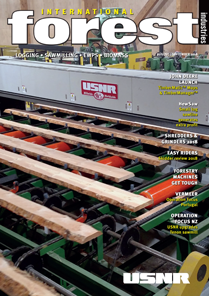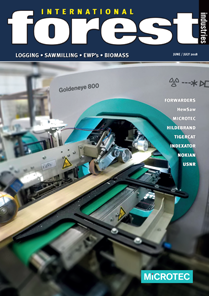EDITOR’S COMMENT ISSUE 66 DEC/JAN 2019
Wood you be without us?
If it’s possible, the forestry sector has become even more indispensable.
The December-January edition of the magazine is probably my favourite for the year, simply because it carries the Industry Voice feature.
Each year, we reach out to some of the leading suppliers in the sector and ask them a range of questions designed to help us form a view of how the market is behaving. It’s an exceptionally instructive exercise.
There is value throughout but in this year’s responses one answer has stayed with me long after reading: “The forestry industry has been robust for several years now and as it continues to offer more growth as the world continues to grasp and warm to the facts that it is an environmentally friendly and renewable resource.”
This came from Tigercat’s International Sales Manager, Gary Olsen, and I’m not sure if a truer, more timely phrase has been uttered in forestry this year.
Logging has traditionally suffered from a double-edged sword: raw materials underpin modern life but cutting down trees in the eyes of many is a grubby way to make a living. It’s a similar scenario to that faced by the hydrocarbon and mining industries.
As the saying goes: Whatever it is you’re looking at, it’s either been dug up or cut down.
But, more recently, forestry has differentiated itself as a raw materials supplier of some moral and environmental merit, while its former contemporaries battle.
Hydrocarbon producers are in the most trouble and they know it. We are in the midst of an energy revolution. This threat has been circling the industry for decades in the form of renewables such as wind, solar and hydropower but while there was no way to store the energy produced during peak times in nature’s cycles for dispersion at peak times in the usage cycle, it has been toothless.
Lithium-ion batteries and increasingly vanadium cells are providing storage solutions for more efficient energy use. At the moment, these batteries are largely confined to cars, which still regularly top up with grid electricity but they are getting bigger and more efficient and there are already batteries powering houses. It won’t be long before sky scrapers are built with cells in the basement.
The metals for green energies, ironically, come from mining. And, while it is difficult to imagine a time when we can do without mining, we are becoming better at recycling and we are, where possible, substituting metals out of civilised uses.
One immediate example that comes to mind is the uptake of wood for large scale construction. Earlier in the year I wrote about the record being challenged for the world’s tallest timber building – a record that continues to change hands as teams from around the world outdo each other with ingenuity and creative wood applications. That skyscraper with a cell in the basement may very well be made of wood.
Forests also play a part in the energy solution and therefore supply a small nail in the hydrocarbon coffin by contributing biomass to the mix.
Yes, biomass is still a carbon-based fuel but forests are also carbon sinks and they are renewable. Biomass uses chips but it also takes advantage of waste products. Both these elements mean it gets a big tick from society.
The world’s population is growing and, by definition, so is consumption. But while other traditional raw material suppliers face an uphill battle, the forestry sector is encouraged to broaden its wings.
There will be market share for just about any product you can imagine up for grabs as the world seeks to limit the extractive industries. Forestry will expand and move into that vacuum as fast as our professionals can innovate and deliver new and better ways to work with wood.
Enjoy
Chris Cann







